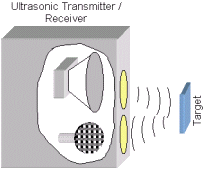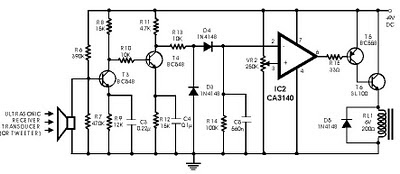Ultrasonic sensor is a sensor that works by emitting a wave and then calculate the time of the reflected wave.
See the picture below:
(Click to enlarge image)
Working at a frequency of ultrasonic waves from 20 kHz up to about 20 MHz. Working frequencies used in ultrasonic wave varies depending on the medium through which, starting from a low density in the gas phase, liquid until padat.Secara ultrasonic waves can be mathematically formulated as follows: (By: http://arifse.blogspot.com/)
s = v.t / 2
where s is the distance in meters, v is the speed of sound is 344 m / sec and t is the travel time in seconds. When an ultrasonic wave hits a barrier it is partially reflected wave will be partially absorbed and some others will be forwarded.
Wave is absorbed will be calculated by the comparator and passed into binanry numbers.
Application
In general, ultrasonic sensors are used to calculate the distance of an object in front of the sensor. So with these functions, ultrasonic sensors commonly used in devices that require distance calculations. Examples: smart robots, ships, submarines, etc..
Here are some sample images of ultrasonic sensors and functions:
PARALAX
(Click to enlarge image)
Ultrasonic Paralax used on the robot - small robots and industrial machinery. can measure the distance from 3 cm to 300 cm.
(By: http://education.web.id)
bacically, Ping))) consists of a chip 40KHz signal generator, an ultrasonic speaker and an ultrasonic microphone. Ultrasonic speaker converts the signals into 40 KHz ultrasonic sounds while the microphone is used to detect the reflected sound. In the module Ping))) there are 3 pins that are used to track the power supply (+5 V), ground and signal. Signal pin can be directly connected with the microcontroller without any additional components. Ping))) detects objects by sending ultrasonic sound and then "listens" to the echoes. Ping))) will only transmit ultrasonic sound when there is a trigger pulse from the microcontroller (high pulse during 5US). Ultrasonic sound with a frequency of 40KHz to be emitted during 200uS. This sound will propagate in the air at speeds 344.424m/detik (or 1cm every 29.034uS), regarding the object and then reflected back to the Ping))). While waiting for reflection, Ping))) will generate a pulse. These pulses will stop (low) when the reflected sound is detected by the Ping))). Hence, the pulse width can represent the distance between the Ping))) with the object. Furthermore, the microcontroller simply measure the width of the pulse and converts it in the form of distance was calculated as follows
Distance = (Width Pulsa/29.034uS) / 2 (in cm)
or
Distance = (pulse-width-x 0.034442) / 2 (in cm)
Because 1/29.034 = 0.34442
(Click to enlarge image)
One thing to note is that the Ping))) can not measure the object surface can absorb sound, such as foam or other sound damper. Distance measurements will also be chaotic if the object surface with a serrated sharp angle (tapered).
For more detail please click
(Click to enlarge image)
WL700 ULTRASONIC WATER LEVEL SENSOR
(Click to enlarge image)
Ranges: 0:17 to 1:00 ft; 0.67 to 3:00 ft; 0.84 to 6:00 ft, and 1.5 to 35 ft
Supply Voltage: 18VDC to 30VDC
Current Draw: 100 mA
Output: 4-20 mA (4 mA is the minimum water level and 20 mA is the maximum water level)
Averaging: 15 second running average (to smooth out water turbulence).
Warm Up Time: 15 seconds
Resolution: Continuous Analog
Operating Temperature Range: -40 ° to 185 ° F (-40 ° to 85 ° C) (1, 3, and 6 ft range)
-40 ° to +145 ° F (-40 ° to 62.8 ° C) (35 ft range only)
Compensated temperature range: -20 ° to 120 ° F (-28 ° to 48 ° C)
Accuracy: +1.0% of Range, +2.0% of 35 ft Range
Beam Angle: 12 °
Material:
1 ft range: aluminum
3, 6, and 35 ft ranges: PVC
Dimensions:
1x2x4 inches (2.5 x 5.1 x 10.2 cm) Rectangular (1 ft range)
1 inch id pipe thread x 4 inches long (2.5 cm ID x 10.2 cm long) (3 ft and 6 ft range)
Id pipe thread 2-1/2 inches x 4 inches long (6.3 cm ID x 10.2 cm long) (35 ft. range)
Weight: 1.5 lbs (0.68 kg)
ULTRASONIC SHEMATICS
(By http://stay-learning.blogspot.com)
Ultrasonic Transmitter
(Click to enlarge image)
Ultrasonic Receiver
(Click to enlarge image)
Hope it helps your activities.
Tags. ultrasonic sensors | ultrasonic sensors | sensors | sensors schematics | receiver ultrasonic | ultrasonic transceiver








I have been your silent reader for long.. Now I think you have to know how much your articles have inspired me to do better. This is very insightful and informative. Thank you for sharing. I would love to see more updates from you.
ReplyDeleteElcometer
There are quite a few places that you might consider to stay for safety issue. But if you need to monitor something like liquid gas or other element from this place then let’s take a quick look without any second thought, you should consider mounting telemetry level sensor. It can be monitor from anywhere through wireless network and the device is suitable for any flammable liquids or gases over hot surface or cold surface. Visit for More details about Telemetry Tank Level Sensor.
ReplyDelete